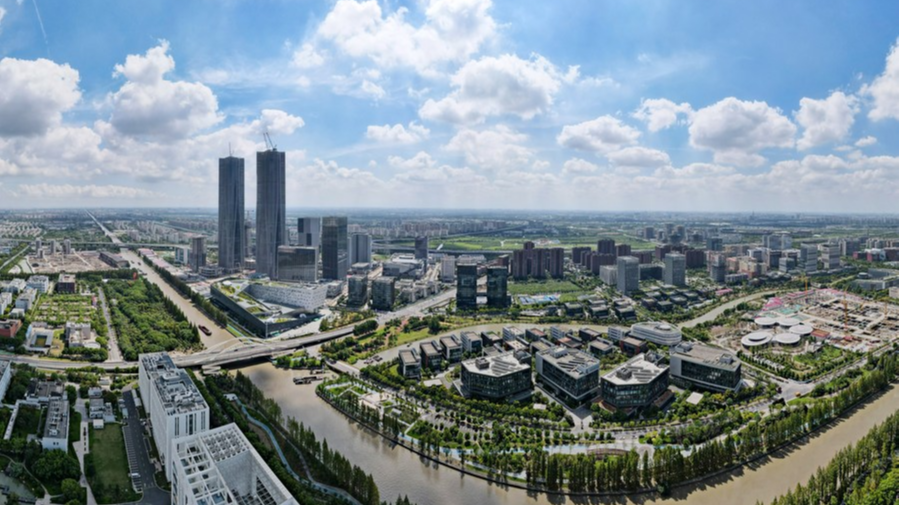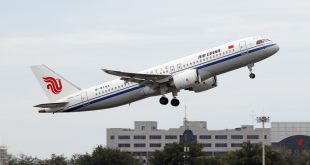Published: July 20,2024
By Wang Huiyao

A view of the Zhangjiang area of the China (Shanghai) Pilot Free Trade Zone in east China’s Shanghai, September 10, 2023. /Xinhua
In recent years, some Western media outlets have often speculated about China’s reforms “stalling” or even “backsliding.” Phrases like “state advances and private sector retreats,” “private sector exit,” and “new state-private partnerships” have been rampant. Against this backdrop, the measures for deepening reforms outlined at the third plenary session of the 20th Central Committee of the Communist Party of China (CPC), which concluded on July 18, have garnered significant attention.
The core issue in the reform of China’s socialist market economy system is how to handle the relationship between the state and the market. A communiqueadopted at the session stated that “a high-standard socialist market economy will provide an important guarantee for Chinese modernization. We must better leverage the role of the market, foster a fairer and more dynamic market environment, and make resource allocation as efficient and productive as possible. We will lift restrictions on the market while ensuring effective regulation, striving to better maintain order in the market and remedy market failures. By doing so, we will ensure smooth flows in the national economy and unleash the internal driving forces and creativity of our society as a whole.”
State-owned, private and foreign-funded enterprises all make enormous and indispensable contributions to China’s economic development. As President Xi Jinping stressed, “We will unswervingly consolidate and develop the public sector and unswervingly encourage, support, and guide the development of the non-public sector. We will ensure that economic entities under all forms of ownership have equal access to factors of production in accordance with the law, compete in the market on an equal footing, and are protected by the law as equals, thus enabling entities under different forms of ownership to complement each other and develop side by side. We will build a unified national market and refine the systems underpinning the market economy.”
Innovation by state-owned enterprises
China’s state-owned enterprises (SOEs) have long faced criticisms of being “big but not strong enough” and “big but not good enough.” With the accelerated development of a new round of technological revolution and industrial transformation, enhancing the competitiveness, innovation, influence and resilience of the state-owned economy is a pressing issue for China. To this end, China has placed independent innovation at the core and maximized the implementation of policies incentivizing innovation. In 2023, China’s central SOEs invested 1.1 trillion yuan($137.8 billion) in research and development.
Since the 18th National Congress of the CPC in 2012, SOEs have pursued breakthroughs and innovation in key technologies and achieved significant technological advancements. For instance, Shenzhen Jinzhou Precision Technology Co., affiliated to China Minmetals, has developed a milling cutter with a diameter of 0.01 millimeter, about one-eighth the thickness of a strand of hair. This is the milling cutter with the smallest diameter in the world and can be used to mill 56 Chinese characters on a single grain of rice.
Moreover, China has been promoting modern corporate systems in SOEs to bolster their vitality from an institutional perspective. Since 2013, the restructuring and reorganization of SOEs have attracted non-state investments of over 2.5 trillion yuan. Currently, mixed-ownership enterprises account for over 70 percent of central enterprises and over 54 percent of local SOEs. Many enterprises have improved corporate governance, increased operational standards, substantially reformed mechanisms, and significantly enhanced vitality and efficiency through mixed-ownership reform.
Timely relief for private enterprises
Private enterprises are a vital force for China’s high-quality development. However, some private enterprises still face heavy tax burdens and a lack of strong policy support. At a meeting, President Xi Jinping once compared such problems to “three mountains” and “three gates,” with the “three mountains” being “the iceberg in markets, the steep mountain in financing, and the volcano in transformation,” while the “three gates” are “the glass door, the spring door, and the revolving door,” and they should all be removed.
Robotic arms process parts for new energy vehicles at a private company in the Changxing Economic and Technological Development Zone, Huzhou City, east China’s Zhejiang Province, January 8, 2024. /Xinhua
To achieve this, China has been creating a better environment for the private sector since the 18th National Congress of the CPC. Over the past decade, the business environment for private enterprises has significantly improved, thanks to various measures such as deepening reforms in simplifying administration and delegation of power, comprehensively improving property rights systems, introducing a nationwide negative list for market access, and releasing the Opinions on Creating a Better Development Environment to Support the Reform and Development of Private Enterprises. According to statistics, the share of private enterprises in the total number of enterprises in China grew from 79.4 percent in 2012 to 96.4 percent in 2024.
In 2023, President Xi instructed to establish a bureau to help resolve the difficulties faced by private enterprises and help the development of the private economy. To relieve the pressure on private enterprises brought by the COVID-19 pandemic, various departments adopted measures such as tax cuts, rent reductions and financing support to reduce the costs of private enterprises, leveraged market mechanisms and administrative measures to expand investment demand, and strengthened legal protection for the development of the private economy. For instance, value-added tax and corporate income tax concessions were provided to industries severely affected by the pandemic, such as transportation, catering, lodging, tourism, courier and civil aviation, offering timely relief for private enterprises.
Swift administrative approval for foreign-funded enterprises
Foreign-funded enterprises are important members of China’s market entities. Attracting and effectively utilizing foreign investment is a crucial part of China’s opening-up strategy. In recent years, China has strategically shifted from offering preferential policies to deepening business environment reforms, protecting the legal rights and interests of foreign-funded enterprises in China by aligning with international economic and trade rules, and enhancing transparency. As a result, the convenience, efficiency and motivation of foreign investment in China have significantly improved. China’s inbound foreign investment (in Chinese yuan) grew steadily for 10 consecutive years from 2013 to 2022 and remained above 1 trillion yuanannually from 2020 to 2023.
Jiangsu Province in east China, which has consistently ranked first nationwide in attracting and utilizing foreign investment, serves as a typical example of China’s efforts. In June 2024, the Samsung Semiconductor Global Logistics Center opened in Suzhou, a major city in Jiangsu. It took Samsung just four days from signing the land use contract to obtaining the construction permit, and only about 400 days from the start of construction to project completion.
Bosch’s new energy vehicle (NEV) project in Suzhou, with a total investment of over $1 billion for the research, development and manufacturing of core components for NEVs and autonomous driving, started construction immediately after acquiring the land. The Swire Coca-Cola project, with a total investment of 2 billion yuan, obtained all the administrative permits simultaneously, taking just eight months from signing to commencement of construction. These projects showcase the efficiency of Jiangsu in facilitating foreign investment.
Despite the slow recovery of the world economy and the accelerated reconstruction of global industrial chains, the overall trend of foreign-funded enterprises expanding their investment in China has not changed. In the first half of 2024, China attracted nearly 500 billion yuan in foreign investment, a high level in the decade. According to the latest data released by the Ministry of Commerce, China established 26,870 new foreign-funded enterprises in the first half of 2024, a year-on-year increase of 14.2 percent, sustaining the rapid growth of new enterprises since last year.
From a macro perspective, China’s economy remains resilient, promising and dynamic. The long-term fundamentals remain positive. This reflects the success of the mixed economy formed under China’s socialist market economy system. In the future, China will continue to implement and advance reform measures, creating a fair competition environment where all market entities can thrive. China will continue to accelerate and deepen its market-oriented reforms, injecting new impetus into the recovery and development of both the Chinese and global economies.
news.cgtn.com
 Africa -China Review Africa -China Cooperation and Transformation
Africa -China Review Africa -China Cooperation and Transformation
